Why Is My Spider Plant Turning Brown or Yellow? Common Leaves Issues
Spider plants (Chlorophytum comosum) are one of the most easy-to-care-for houseplants that add a touch of greenery to any interior space. Native to Central and Southern Africa, these potted plants quickly adapt to their surroundings and can last many years without much attention. Neglecting them, however, may result in browning, yellowing, curling, or bending leaves.
But why is your spider plant turning brown or yellow exactly? These problems often occur when the plant is getting too much light or not enough water, as well as insufficient light exposure, or is affected by pests like flea beetles and aphids.
In this guide, we'll explore several spider plant common leaf issues in detail and help you learn how to address them effectively.
Common Spider Plant Leaves Issues: Reasons & Solutions
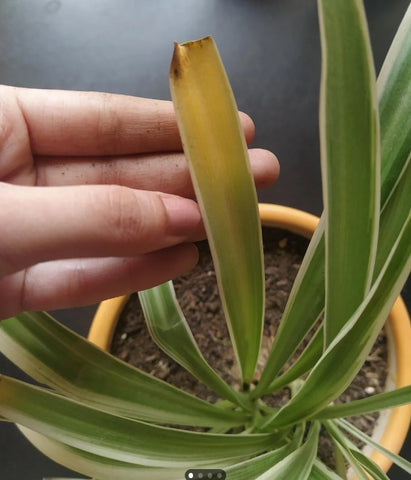
The spider plant, also known as spider ivy, is a rather resilient indoor houseplant, which is a rapid grower with an adaptable nature. They are popular for producing gorgeous plantlets after their first year that are used for fast and effective spider plant propagation. But if your Chlorophytum comosum plant doesn’t receive the right growing conditions, it can suffer from various issues, be it its leaves turning brown and yellow, or they start to droop, bend, and curl.
Read on to find out what exactly is causing these problems and how to fix them.
Spider Plant Leaves Turning Brown: Causes and Fixes
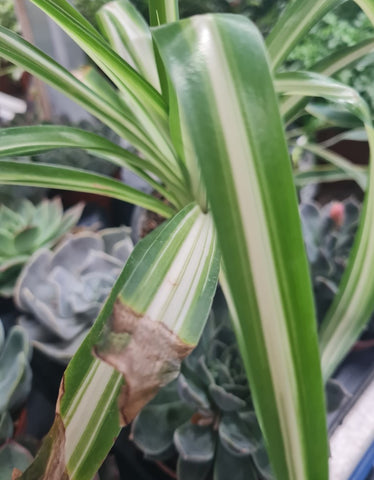
Spider plants, although quite hardy, are commonly susceptible to their leaves turning brown. Brown tips on spider plants can be caused by poor care and various environmental factors. leaves.
Why Does My Spider Plant Have Brown Tips?
Your spider plant may have brown tips due to:
- Underwatering that results in crisp, browning foliage
- Drafts, if you keep your plant near air vents
- Low humidity levels in the air
- Overfertilization, which leads to plant toxicity
- Exposure to direct light that causes leaf burn
- Plant diseases and pests, such as aphids
Should You Cut the Brown Tips Off Spider Plants?
You can cut the brown tips off your spider plant to get back the aesthetically pleasing appearance of your green companion. The damaged fronds may not affect your plant’s overall health but pruning them will make your spider plant look so much better.
To prevent further browning, ensure you water your spider plant regularly. Use fluoride-free water, if possible, as spider plants are very sensitive to this chemical. The best way to deal with low humidity levels is to mist your spider ivy regularly or place it on a pebble tray. Turning on a humidifier in the room will also work.
If you’ve overfertilized your spider plant, remove the excess salts and minerals by flushing the soil with distilled water. Lastly, shift your plant to another location that receives bright yet indirect light for at least 4-6 hours. Direct light isn’t good for your beloved tropical plant.
Spider Plant Yellow Leaves: Reasons and Solutions
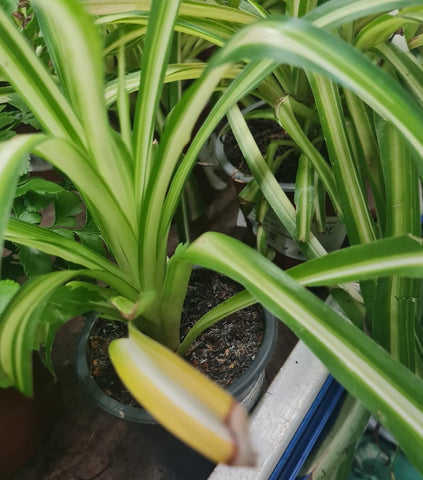
When your spider plant leaves start yellowing, this means that your plant care efforts are lacking and might need adjustments.
Why Is My Spider Plant Leaves Turning Yellow?
Your spider plant leaves are turning yellow because of the following reasons:
- Overwatering
- Too high or too low temperature
- Insufficient or too much light
- Low humidity or lack of nutrients in the soil
- Aging
How Do You Fix Yellow Leaves on a Spider Plant?
Fixing the yellow leaves on your spider plant is easier than you think. Avoid overwatering your plant by letting its soil dry out completely before watering it again. Prevent your spider plant from exposure to extreme temperature fluctuations and ensure its growing environment is neither too hot nor too cold. The same goes for the light your plant receives daily. Bright, indirect light helps spider plants flourish.
Also, maintain ideal humidity levels indoors, preferably medium to high, to mimic the native tropical conditions for your spider plant. Counteract nutrient deficiency by feeding your spider plant in the growing season. Last but not least, repot your spider plant every two years despite their tolerance to be root-bound.
Why Do the Leaves on My Spider Plant Bending?
If you notice your spider plant leaves bending, improper watering, insufficient sunlight, incorrect feeding, and pest infestations could be blamed here. Also, the weight of dangling spiderettes (the baby spider plants) at the end of the runners can cause a droopy appearance. Prune those or use them to multiply your main spider plant and give new plants as gifts to friends.
What to Do When a Spider Plant Leaves Bend?
Start by assessing your spider plant's environment. It should be getting adequate sunlight, water, and proper drainage. Bent leaves will recover, as long as you meet your plant's care and growing needs. Consider repotting the plant in fresh, nutrition-rich soil to rejuvenate it. Additionally, adjust the humidity levels around the plant by misting it occasionally or placing a pebble tray nearby.
Why Are My Spider Plant Leaves Curling Up?
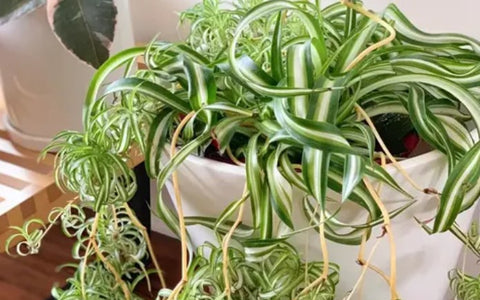
Long, arching leaves of your spider plant may curl, due to over/underwatering, water purity issues, soil pH, root rot, root crowdedness, and direct sunlight.
Solutions for Spider Plant Leaves Curling
Some workarounds to fix curling spider plant leaves include following the right watering schedule and avoiding regular tap water when hydrating the plant It’s rich in chlorine and fluoride, which aren’t good for houseplants.
In addition, it’s a good practice to let the soil dry out completely before you water it again. This will prevent the roots from rotting or getting attacked by pests. If it has been a long time since you moved your spider plant into a larger container with fresh soil, consider repotting it.
Pro Tip: Spider plants prefer slightly alkaline soil with a pH of 6.1 to 6.5. So, use a pH meter to know if the soil is alkaline enough.
Spider Plant Leaf Problems: Prevention and Care
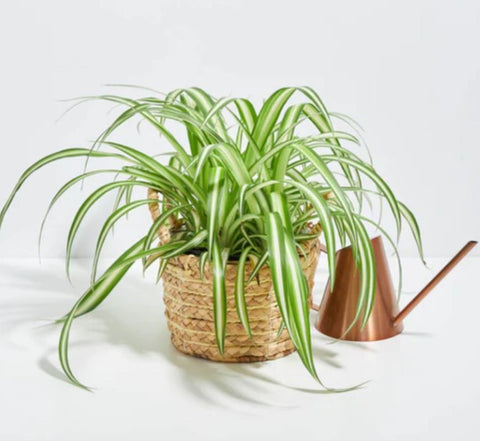
Here’s a quick roundup of some essential spider plant care tips that will help you prevent all these common leaf problems:
- Place your spider ivy near a window or glass door that receives bright, indirect light.
- This plant hates soggy soil, and thus, only water it when the topsoil feels dry to the touch.
- A neural or slightly acidic/alkaline soil works best for the spider plants.
- Don’t overfertilize your spider plant, and only use an all-purpose granular or water-soluble fertilizer.
- Maintain a 60°F to 80°F temperature range for your Chlorophytum comosum, along with medium to high humidity.
- Regularly inspect your plant’s soil and foliage for any insect issues.
Spider Plant Leaf Issues: FAQs
Q: What is the white fuzz on my spider plant?
A: The white fuzz on your spider plant is probably powder mildew. It’s a type of fungus that covers the plant’s leaves and stems with what looks like powdered sugar, hence the name.
Q: What are the little flies around my spider plant?
A: The little flies around your spider plant can be fungus gnats (Sciaridae). They are dark, delicate-looking flies with transparent wings, just like mosquitoes.
Q: What does an overwatered spider plant look like?
A: An overwatered spider plant looks droopy, with leaves turning yellow, brown, or curling up.
Q: Should I remove yellow leaves from my spider plant?
A: Yes, you should remove any yellow leaves from your spider plant. This will let the plant focus its energy on its healthy leaves.
Q: Why do spider plant leaves droop?
A: Spider plant leaves can droop for several reasons, like lack of moisture, low humidity, scorching heat, extreme cold, root rot, and diseases.
Conclusion
No matter how resilient spider plants are, they can still experience issues like browning or yellowing leaves. Understanding the common causes, such as overwatering, underwatering, or inadequate lighting, is crucial for addressing these problems promptly.
By providing proper care and attention, you can help your spider plant thrive and maintain its vibrant green foliage for years to come.












Leave a comment